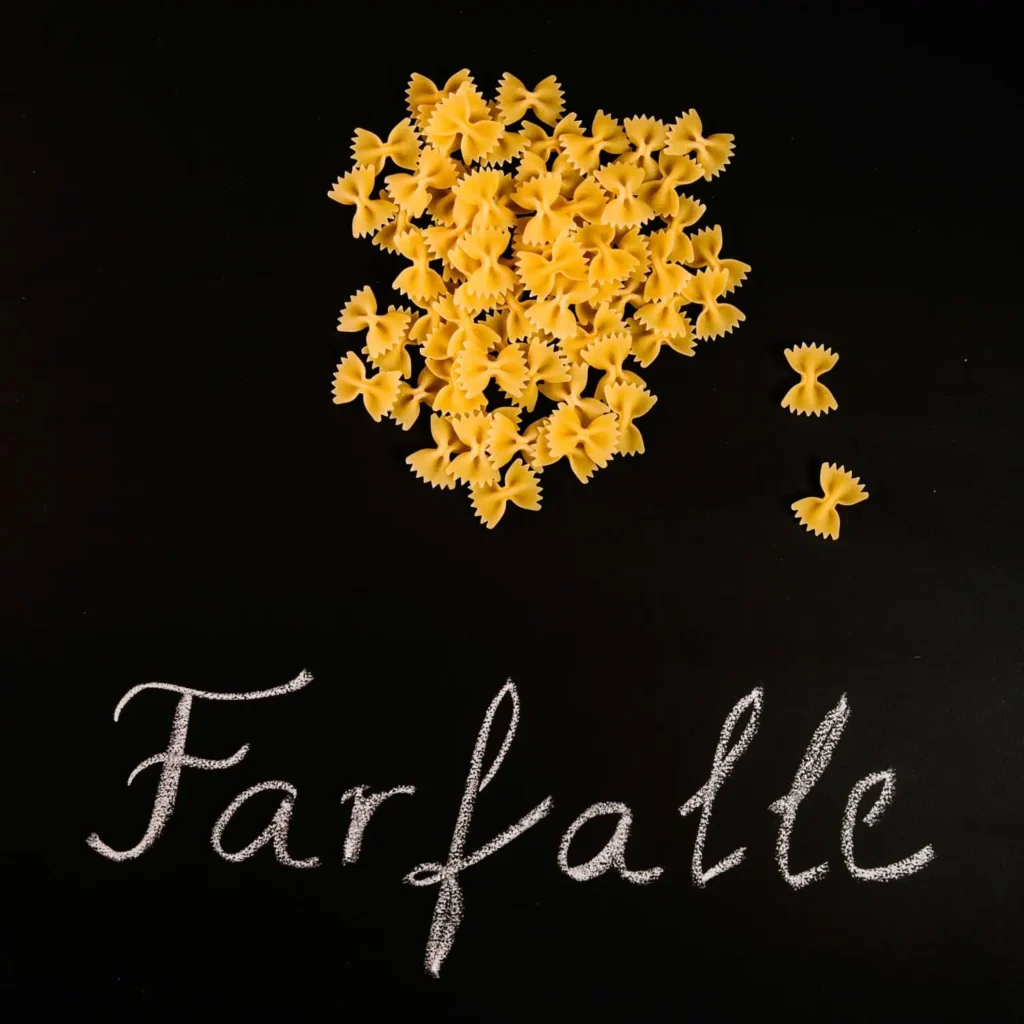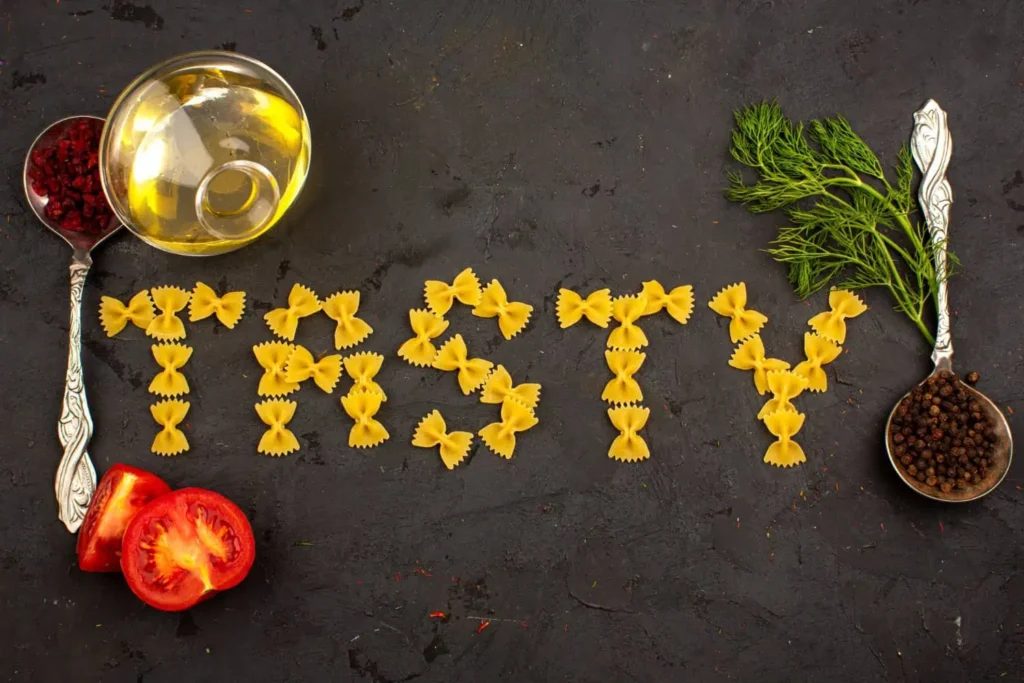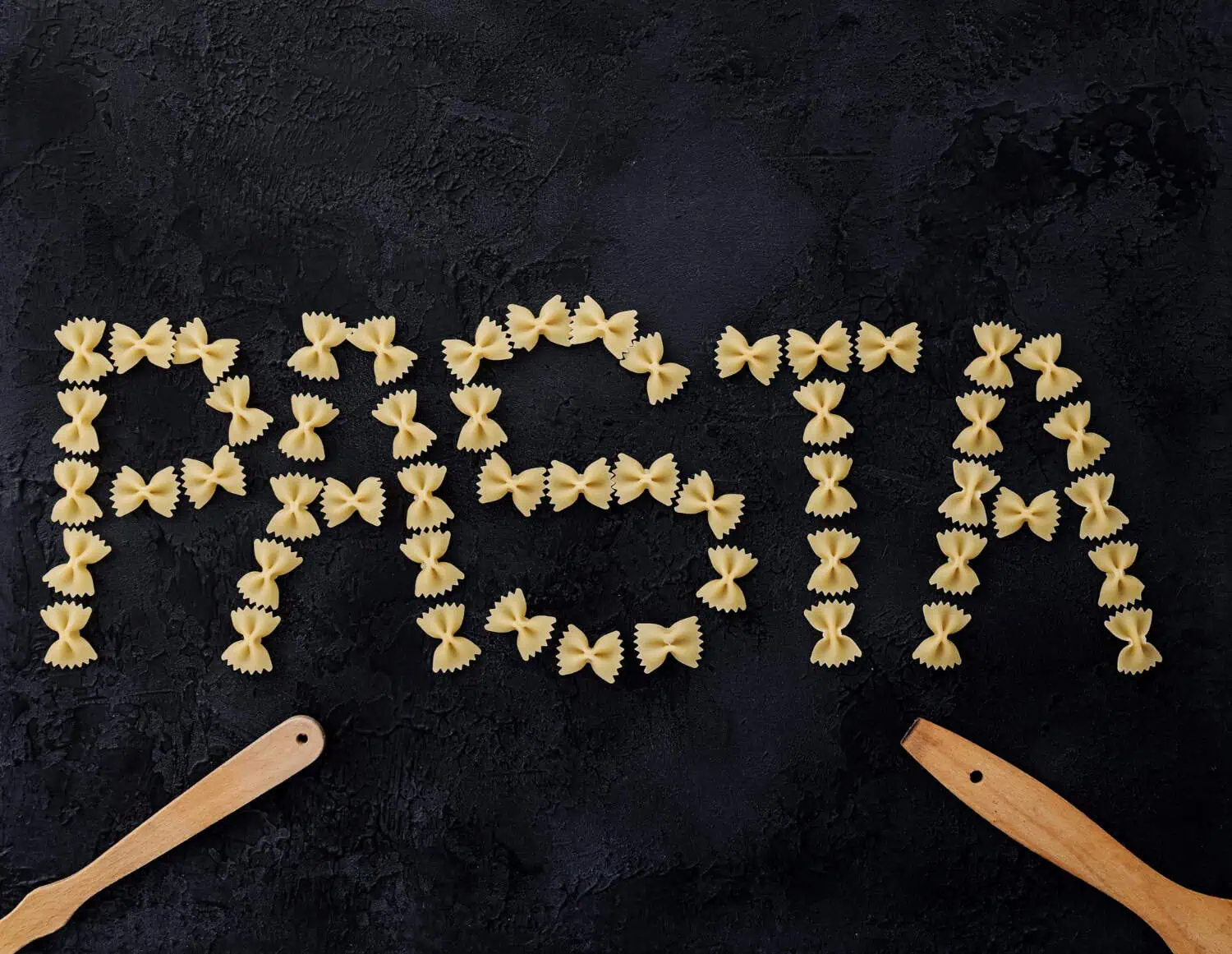If you’ve ever come across the adorable, bow-shaped pasta in your favorite Italian dishes, you might have wondered, “What is the fancy name for bowtie pasta?” The answer is farfalle! This elegant name, derived from the Italian word for “butterflies,” perfectly describes the pasta’s unique shape. Farfalle is not only visually appealing but also incredibly versatile, making it a favorite in kitchens worldwide.
In this article, we’ll dive deep into everything you need to know about farfalle pasta, including its origins, uses, and how to cook it perfectly. We’ll also answer some of the most frequently asked questions about this delightful pasta shape. So, let’s get started!
What Is Farfalle Pasta?
Farfalle, pronounced far-FALL-eh, is the fancy name for bowtie pasta. Its name comes from the Italian word farfalla, which means butterfly. The pasta’s shape resembles a bowtie or butterfly, with a pinched center and flared edges. This unique design not only makes it visually appealing but also helps it hold sauces beautifully.
Farfalle is a staple in Italian cuisine and is often used in both hot and cold dishes. Its versatility and charming appearance make it a popular choice for pasta salads, creamy sauces, and even baked dishes.
Characteristics of Farfalle Pasta
Farfalle pasta has several distinctive characteristics that set it apart from other pasta shapes:
- Shape: The bowtie shape is created by pinching a rectangular piece of pasta in the center, resulting in two flared wings.
- Texture: Farfalle has a slightly ridged surface, which helps it cling to sauces and ingredients.
- Size: Farfalle comes in various sizes, from small (farfalline) to large (farfalloni), allowing for different culinary applications.
These characteristics make farfalle a versatile choice for a wide range of recipes, from simple weeknight dinners to elegant gatherings.
The History of Farfalle Pasta
Farfalle pasta has a rich history that dates back to the 16th century in Northern Italy, particularly in the regions of Emilia-Romagna and Lombardy. It was originally created as a way to use up leftover pasta dough. The dough was cut into small rectangles, pinched in the middle, and shaped into the iconic bowtie form.
Over time, farfalle became a beloved pasta shape, not just in Italy but around the world. Its playful design and ability to pair well with a variety of sauces have cemented its place in Italian culinary tradition.
Evolution of Pasta Shapes
The evolution of pasta shapes is a fascinating journey that reflects the cultural and culinary influences of different regions. In Italy, pasta shapes were often created based on local ingredients, cooking methods, and traditions. Farfalle is just one example of how creativity and resourcefulness led to the development of unique pasta shapes.
- Regional Variations: Different regions of Italy have their own traditional pasta shapes. For example, orecchiette from Puglia, trofie from Liguria, and pici from Tuscany all showcase the diversity of Italian pasta.
- Culinary Influence: The introduction of new ingredients, such as tomatoes and cheese, influenced the development of pasta shapes that could hold these flavors effectively.
Farfalle’s design is a testament to the ingenuity of Italian cooks who sought to create a pasta shape that was not only functional but also visually appealing.
How to Cook Farfalle Pasta Perfectly
Cooking farfalle pasta is simple, but there are a few tips to ensure it turns out perfectly every time. Here’s a step-by-step guide:
- Boil Water: Bring a large pot of salted water to a rolling boil. Use about 4-6 quarts of water for every pound of pasta. The salt enhances the flavor of the pasta.
- Add Farfalle: Add the farfalle to the boiling water and stir to prevent sticking. Stirring is crucial, especially in the first few minutes of cooking.
- Cook Al Dente: Cook the pasta for 10-12 minutes, or until it’s al dente (firm to the bite). Check the package instructions for exact cooking times, as they can vary by brand.
- Taste Test: A minute or two before the suggested cooking time, taste a piece of pasta. It should be cooked through but still have a slight bite.
- Drain and Serve: Drain the pasta in a colander and toss it with your favorite sauce or ingredients. If you’re using a sauce, consider reserving a cup of pasta water to adjust the sauce’s consistency.
Pro Tips for Cooking Farfalle:
- Use Plenty of Water: Using a large pot of water allows the pasta to move freely, preventing it from sticking together.
- Stir Occasionally: Stirring the pasta occasionally during cooking helps prevent it from clumping.
- Save Pasta Water: The starchy water can be used to thin out sauces and help them adhere to the pasta better.
Common Mistakes to Avoid
When cooking farfalle, there are a few common mistakes to avoid:
- Not Salting the Water: Salt enhances the flavor of the pasta, so don’t skip this step.
- Overcooking: Cooking pasta too long can result in a mushy texture. Always aim for al dente.
- Rinsing the Pasta: Rinsing cooked pasta removes the starch that helps sauces cling to it. Only rinse if you’re making a cold pasta salad.
By following these tips, you can ensure that your farfalle pasta is cooked to perfection every time.
Popular Dishes Featuring Farfalle Pasta
Farfalle pasta is incredibly versatile and works well in a variety of dishes. Here are some popular recipes that showcase its unique shape and texture:
1. Creamy Farfalle Alfredo
Farfalle pairs beautifully with rich, creamy sauces like Alfredo. The bowtie shape holds the sauce, ensuring every bite is flavorful. To make a simple Alfredo sauce, combine heavy cream, butter, and grated Parmesan cheese in a saucepan. Toss the cooked farfalle in the sauce and garnish with parsley.
2. Farfalle Pasta Salad
Cold pasta salads are a great way to use farfalle. Toss it with fresh vegetables, olive oil, and a tangy vinaigrette for a refreshing dish. Add ingredients like cherry tomatoes, cucumbers, bell peppers, and olives for a colorful and nutritious salad.
3. Farfalle with Pesto
The ridges and folds of farfalle make it perfect for holding pesto sauce. Blend fresh basil, garlic, pine nuts, Parmesan cheese, and olive oil to create a vibrant pesto. Toss the cooked farfalle with the pesto and add grilled chicken or shrimp for a complete meal.
4. Baked Farfalle Casserole
Layer farfalle with marinara sauce, cheese, and your favorite toppings for a comforting baked pasta dish. Combine cooked farfalle with marinara sauce, ricotta cheese, and mozzarella, then bake until bubbly and golden.
5. Farfalle with Vegetables
For a lighter option, sauté farfalle with seasonal vegetables, garlic, and olive oil. This dish is perfect for showcasing fresh produce and can be customized with whatever vegetables you have on hand.
6. Farfalle Primavera
Farfalle primavera is a colorful dish that features a variety of fresh vegetables. Sauté vegetables like zucchini, bell peppers, and asparagus in olive oil, then toss with cooked farfalle and a sprinkle of Parmesan cheese.
7. Farfalle with Sausage and Broccoli Rabe
This hearty dish combines farfalle with Italian sausage and broccoli rabe. Sauté the sausage until browned, then add garlic and broccoli rabe. Toss with cooked farfalle and a splash of pasta water for a delicious meal.
8. Farfalle with Tomato and Mozzarella
For a simple yet flavorful dish, toss cooked farfalle with diced tomatoes, fresh mozzarella, basil, and a drizzle of balsamic glaze. This dish is perfect for summer and can be served warm or cold.
9. Farfalle with Spinach and Ricotta
Combine cooked farfalle with sautéed spinach and ricotta cheese for a creamy and satisfying dish. Add a touch of nutmeg for extra flavor.
10. Farfalle with Lemon and Shrimp
Sauté shrimp in olive oil and garlic, then toss with cooked farfalle, lemon juice, and zest for a bright and refreshing meal. Garnish with parsley for a pop of color.

Why Is Farfalle Called Bowtie Pasta?
Farfalle is often called bowtie pasta because of its distinctive shape, which resembles a bowtie. However, the fancy name for bowtie pasta is farfalle, which means “butterflies” in Italian. The name “bowtie pasta” is more commonly used in English-speaking countries, while Italians stick to the traditional term.
The Cultural Significance of Pasta Names
The names of pasta shapes often reflect their cultural significance and regional origins. In Italy, pasta names can vary significantly from one region to another, and many shapes have historical or geographical ties. For example:
- Orecchiette: This pasta, which means “little ears,” is named for its shape and is a specialty of Puglia.
- Fusilli: The name comes from the Italian word for “spindle,” reflecting the twisted shape of the pasta.
- Penne: This pasta is named for its resemblance to a quill pen, with its diagonal cut ends.
Understanding the names and origins of pasta shapes adds depth to your culinary experience and appreciation for Italian cuisine.
What Sauces Go Best with Farfalle?
Farfalle is a versatile pasta that pairs well with a variety of sauces. Here are some of the best options:
- Creamy Sauces: Alfredo, carbonara, or any cheese-based sauce. The shape of farfalle allows it to hold onto creamy sauces beautifully.
- Tomato-Based Sauces: Marinara, arrabbiata, or Bolognese. The ridges of farfalle help capture the sauce, ensuring a flavorful bite.
- Pesto: Classic basil pesto or sun-dried tomato pesto. The unique shape of farfalle allows it to hold onto the chunky texture of pesto.
- Light Sauces: Olive oil, garlic, and lemon-based sauces. Farfalle works well with lighter sauces that highlight fresh ingredients.
The bowtie shape and pinched center of farfalle make it ideal for holding both thick and light sauces, ensuring a delicious bite every time.
Pairing Farfalle with Ingredients
When creating a dish with farfalle, consider pairing it with complementary ingredients to enhance the overall flavor. Here are some ideas:
- Proteins: Grilled chicken, shrimp, Italian sausage, or chickpeas can add protein and substance to your dish.
- Vegetables: Seasonal vegetables like zucchini, bell peppers, spinach, and asparagus can add color and nutrition.
- Herbs and Spices: Fresh herbs like basil, parsley, and oregano can elevate the flavor profile of your dish.
By thoughtfully pairing farfalle with various ingredients, you can create a well-rounded and satisfying meal.
Nutritional Benefits of Farfalle Pasta
Farfalle pasta is made from durum wheat semolina, which is high in protein and provides a good source of energy. Here’s a quick look at its nutritional profile (per 100g of cooked pasta):
- Calories: 157
- Carbohydrates: 31g
- Protein: 5g
- Fat: 1g
- Fiber: 1.8g
For a healthier option, you can also find whole wheat or gluten-free farfalle pasta, which offers additional fiber and nutrients.
Health Benefits of Whole Wheat Farfalle
Whole wheat farfalle is a great alternative to traditional pasta, as it retains the bran and germ of the wheat, providing more fiber and nutrients. Here are some benefits of choosing whole wheat farfalle:
- Higher Fiber Content: Whole wheat pasta contains more fiber, which aids in digestion and helps maintain a healthy weight.
- Nutrient-Rich: Whole wheat pasta is a good source of B vitamins, iron, and magnesium, which are essential for overall health.
- Lower Glycemic Index: Whole wheat pasta has a lower glycemic index compared to regular pasta, making it a better option for blood sugar control.
Incorporating whole wheat farfalle into your diet can contribute to a balanced and nutritious meal plan.
Fun Facts About Farfalle Pasta
- Oldest Pasta Shape: Farfalle is one of the oldest pasta shapes, dating back to the 16th century.
- Regional Names: In some regions of Italy, farfalle is also known as strichetti.
- Colorful Variations: Colored farfalle, made with spinach, beetroot, or squid ink, adds a fun twist to dishes and can be used for special occasions.
- Culinary Versatility: Farfalle can be used in a variety of cuisines beyond Italian, including Mediterranean and American dishes.
These fun facts highlight the cultural significance and culinary versatility of farfalle pasta, making it a delightful addition to any meal.

FAQs About Farfalle Pasta
1. What is the fancy name for bowtie pasta?
The fancy name for bowtie pasta is farfalle, which means “butterflies” in Italian.
2. What is farfalle pasta used for?
Farfalle is used in a variety of dishes, including pasta salads, creamy sauces, baked casseroles, and light vegetable-based recipes.
3. Is farfalle the same as bowtie pasta?
Yes, farfalle and bowtie pasta are the same. “Bowtie pasta” is the English term, while “farfalle” is the Italian name.
4. What sauces go best with farfalle?
Farfalle pairs well with creamy sauces, tomato-based sauces, pesto, and light olive oil-based sauces.
5. How do you pronounce farfalle?
Farfalle is pronounced far-FALL-eh.
6. Can I use farfalle in soup?
Yes, farfalle works well in soups, especially minestrone or chicken noodle soup, as its shape holds up well in broth.
7. Is farfalle pasta healthy?
Farfalle pasta is a good source of energy and can be part of a balanced diet. Opt for whole wheat or gluten-free versions for added health benefits.
8. How should I store farfalle pasta?
Store dry farfalle in an airtight container in a cool, dry place for up to 2 years. Cooked farfalle can be stored in the refrigerator for 3-5 days or frozen for up to 2 months.
9. Can I make farfalle from scratch?
Yes, you can make farfalle from scratch using flour, eggs, and water. Roll out the dough, cut it into rectangles, and pinch the centers to create the bowtie shape.
10. What is the best way to reheat cooked farfalle?
To reheat cooked farfalle, add a splash of water or sauce to a skillet and heat over low heat until warmed through. You can also microwave it with a little water to prevent drying out.
How to Store Farfalle Pasta
Proper storage is essential to keep your farfalle pasta fresh. Here’s how to store it:
- Dry Farfalle: Store in an airtight container in a cool, dry place. It can last up to 2 years.
- Cooked Farfalle: Store in an airtight container in the refrigerator for up to 3-5 days. Add a little olive oil to prevent sticking.
- Freezing Cooked Farfalle: Freeze cooked farfalle in a freezer-safe container for up to 2 months. Thaw and reheat as needed.
Tips for Storing Pasta
- Avoid Moisture: Keep dry pasta away from moisture to prevent it from spoiling.
- Label Containers: If you freeze cooked farfalle, label the container with the date to keep track of freshness.
- Use Airtight Containers: Using airtight containers helps maintain the quality of both dry and cooked pasta.
By following these storage tips, you can ensure that your farfalle pasta stays fresh and ready to use whenever you need it.
Where to Buy Farfalle Pasta
Farfalle pasta is widely available in grocery stores, specialty Italian markets, and online. Look for high-quality brands made from 100% durum wheat semolina for the best texture and flavor. You can also find artisanal farfalle in unique colors and flavors, such as spinach, tomato, or squid ink.
Choosing the Right Farfalle
When purchasing farfalle, consider the following:
- Quality: Look for brands that use high-quality ingredients and traditional production methods.
- Type: Decide whether you want regular, whole wheat, or gluten-free farfalle based on your dietary preferences.
- Size: Farfalle comes in various sizes, so choose the one that best fits your recipe.
By selecting the right farfalle, you can enhance your culinary creations and enjoy the delightful taste and texture of this beloved pasta shape.
Final Thoughts: Why Farfalle Is More Than Just Bowtie Pasta
Now that you know what the fancy name for bowtie pasta is—farfalle—you can appreciate this delightful pasta shape even more. Its rich history, versatility, and ability to elevate any dish make it a must-have in your pantry. Whether you’re whipping up a quick pasta salad or preparing a gourmet Italian feast, farfalle is sure to impress.
So, the next time you’re at the store or planning a meal, don’t just call it bowtie pasta—embrace its fancy name and enjoy the charm of farfalle!
With its unique shape and culinary versatility, farfalle pasta is a delightful addition to any meal. From creamy sauces to vibrant salads, this pasta shape can elevate your dishes and impress your guests. So, gather your ingredients, get creative in the kitchen, and enjoy the delicious world of farfalle pasta! 🍝
This comprehensive guide on farfalle pasta not only answers the question of its fancy name but also provides insights into its history, cooking methods, and culinary applications. With this knowledge, you can confidently explore the many delicious possibilities that farfalle has to offer. Happy cooking!

